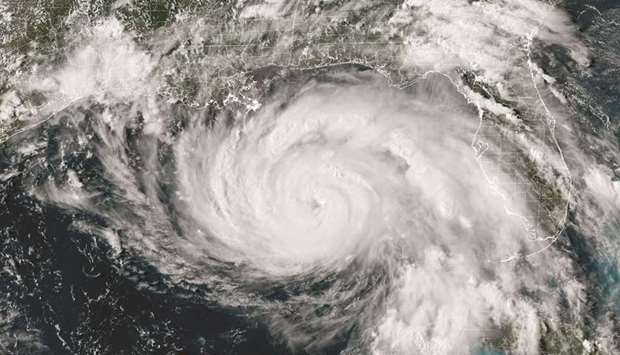At least one person has died and power is out across Louisiana and Mississippi yesterday as officials warned residents against venturing out on roads littered with downed power lines and debris from Ida, which remains a powerful storm.
Virtually no one in the state has electricity and many water systems are also out, Louisiana Governor John Bel Edwards said.
“The biggest concern is we’re still doing search and rescue and we have individuals all across southeast Louisiana... who are in a bad place,” he told the Today show yesterday morning.
One death has been confirmed so far but Edwards said he expected the toll “to go up considerably.”
One person was killed by a falling tree in Prairieville, 60 miles northwest of New Orleans, the Ascension Parish Sheriff’s Office said.
Emergency 911 service was also not available in New Orleans in the wake of the powerful Category 4 hurricane that slammed into the state a day earlier.
The death toll was likely to increase, Edwards told MSNBC, and he posted on Twitter that the state had deployed 1,600 search-and-rescue personnel.
“Please remain sheltered in place. Although you may be tempted to go explore, conditions are still very dangerous,” the City of New Orleans Emergency Medical Services wrote on Twitter.
President Joe Biden declared a major disaster in the state, ordering federal assistance to bolster recovery efforts.
US Army Major-General Hank Taylor told journalists at a Pentagon briefing that the military, FEMA officials and the National Guard had activated more than 5,200 personnel in Louisiana, Mississippi, Texas, and Alabama.
“They bring a variety of assets including high water vehicles, rotary lift and other transportation capability to support recovery efforts,” he said.
Ida crashed ashore as Louisiana was already reeling from a resurgence of coronavirus (Covid-19) infections that has strained the state’s healthcare system, with an estimated 2,450 Covid-19 patients hospitalised statewide, many in intensive care units.
The storm’s arrival came 16 years to the day after Hurricane Katrina, one of the most catastrophic and deadly US storms on record, struck the Gulf Coast, and about a year after the last Category 4 hurricane, Laura, battered Louisiana.
Federal Emergency Management Agency (FEMA) administrator Deanne Criswell said that the full impact of the storm would become clear later in the day.
“We’re hearing about widespread structural damage,” she said in an interview with CNN. “I don’t think there could have been a worse path for this storm. It’s going to have some significant impacts.”
Images of people being plucked from flooded cars and pictures of destroyed homes surfaced on social media, while the damage in New Orleans itself remained limited.
Branches, broken glass and other debris littered New Orleans’s downtown, while in the touristy French Quarter, a number of trees were uprooted.
“I was there 16 years ago. The wind seems worse this time but the damage seems less bad,” said French Quarter resident Dereck Terry, surveying his neighbourhood in flip flops and a T-shirt, umbrella in hand.
“I have a broken window. Some tiles from the roof are on the streets and water came inside,” the 53-year-old retired pharmacist added.
Most residents had heeded warnings of catastrophic damage and authorities’ instructions to flee.
“I stayed for Katrina and from what I’ve seen so far there is way less debris in the streets than after Katrina,” fellow French Quarter resident Mike told AFP yesterday, declining to give his last name.
Federal levees appeared to have held.
Hundreds of miles of new levees were built around New Orleans after flooding from Katrina inundated much of the low-lying city, especially historically black neighbourhoods.
In the town of Jean Lafitte, just south of New Orleans, mayor Tim Kerner said the rapidly rising waters had overtopped the 7.5-foot-high (2.3m) levees.
“Total devastation, catastrophic, our town levees have been overtopped,” Kerner told ABC-affiliate WGNO.
“We have anywhere between 75-200 people stranded in Barataria” after a barge took out the swing bridge to the island.
Cynthia Lee Sheng, president of Jefferson Parish covering part of the Greater New Orleans area, said people were sheltering in their attics.
Several residents of LaPlace, just upstream from New Orleans, posted appeals for help on social media, saying they were trapped by rising flood waters.
“The damage is really catastrophic,” Governor Edwards told Today, adding that Ida had “delivered the surge that was forecast. The wind that was forecasted and the rain”.
Ida lost some of its punch as it grinded over southwestern Mississippi yesterday, but the system, downgraded to a tropical storm, could still trigger heavy flooding throughout the region, the National Hurricane Centre (NHC) said.
A loss of generator power at the Thibodaux Regional Health System hospital in Lafourche Parish, southwest of New Orleans, forced medical workers to manually assist respirator patients with breathing while they were moved to another floor, the state Health Department confirmed to Reuters on Sunday.
Power was knocked out on Sunday night to the entire New Orleans metropolitan area following the failure of all eight transmission lines that deliver electricity to the city, the utility company Entergy Louisiana reported.
One transmission tower collapsed into the Mississippi River, the Jefferson Parish Emergency Management Department said.
Just over 1mn Louisiana homes and businesses were without electricity yesterday, as well as nearly 130,000 in Mississippi, according to the tracking site PowerOutage.
Ida pummelled US Gulf Coast energy suppliers, knocking out most of the region’s offshore wells and nearly half its motor fuel production and drove prices broadly higher.
Scientists have warned of a rise in cyclone activity as the ocean surface warms due to climate change, posing an increasing threat to the world’s coastal communities.

This National Oceanic and Atmospheric Administration (NOAA) handout image shows Hurricane Ida late on Saturday.
